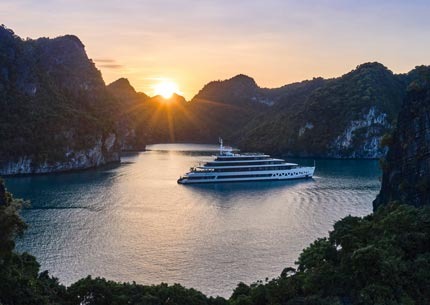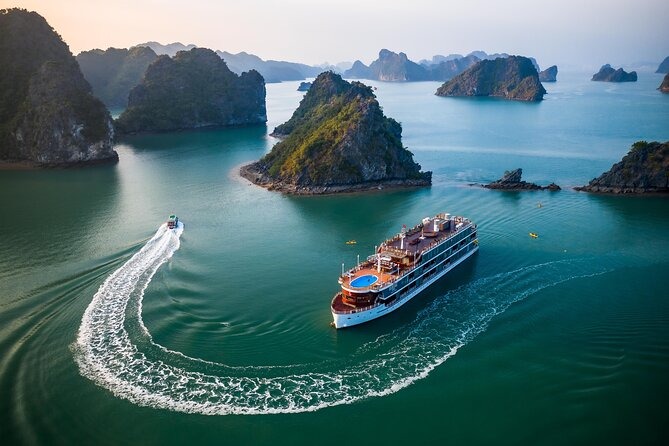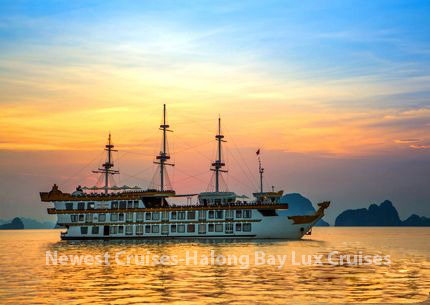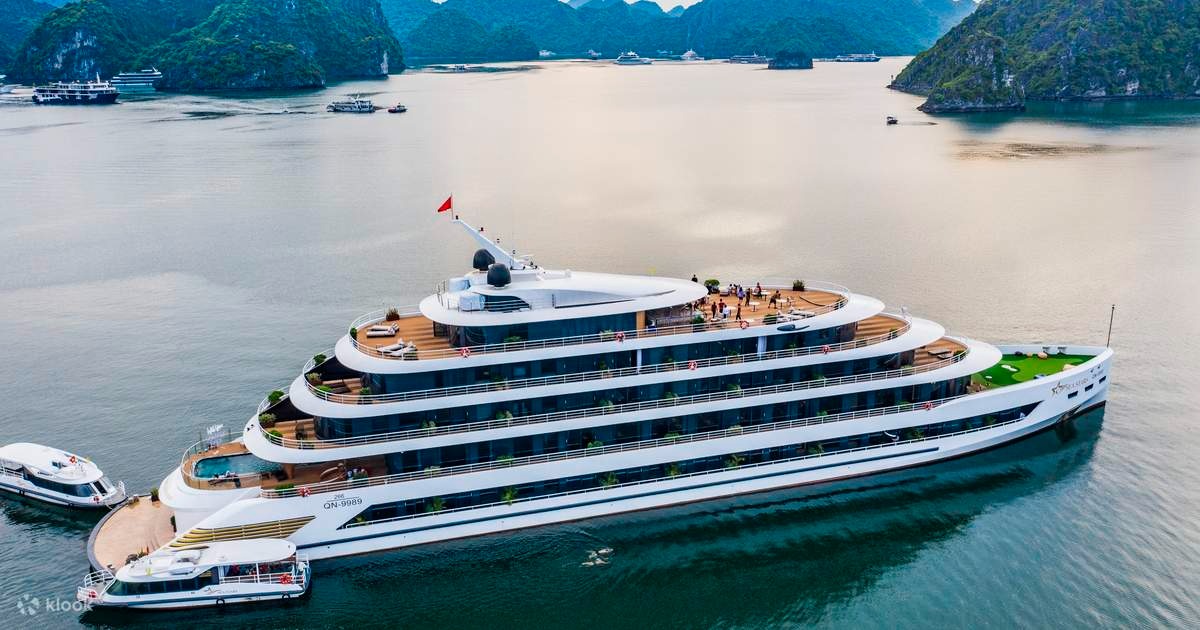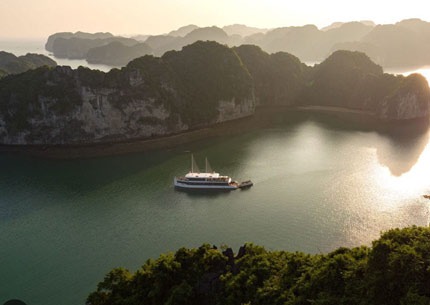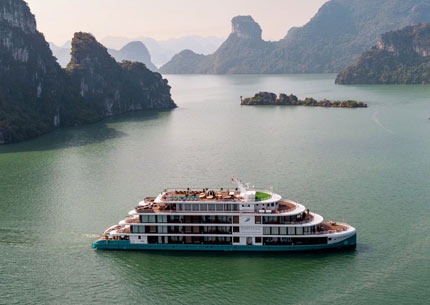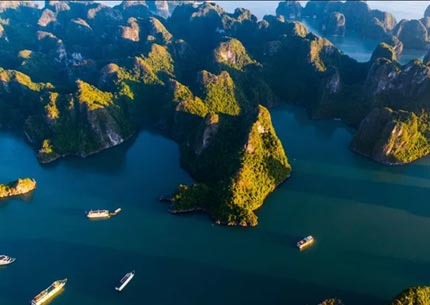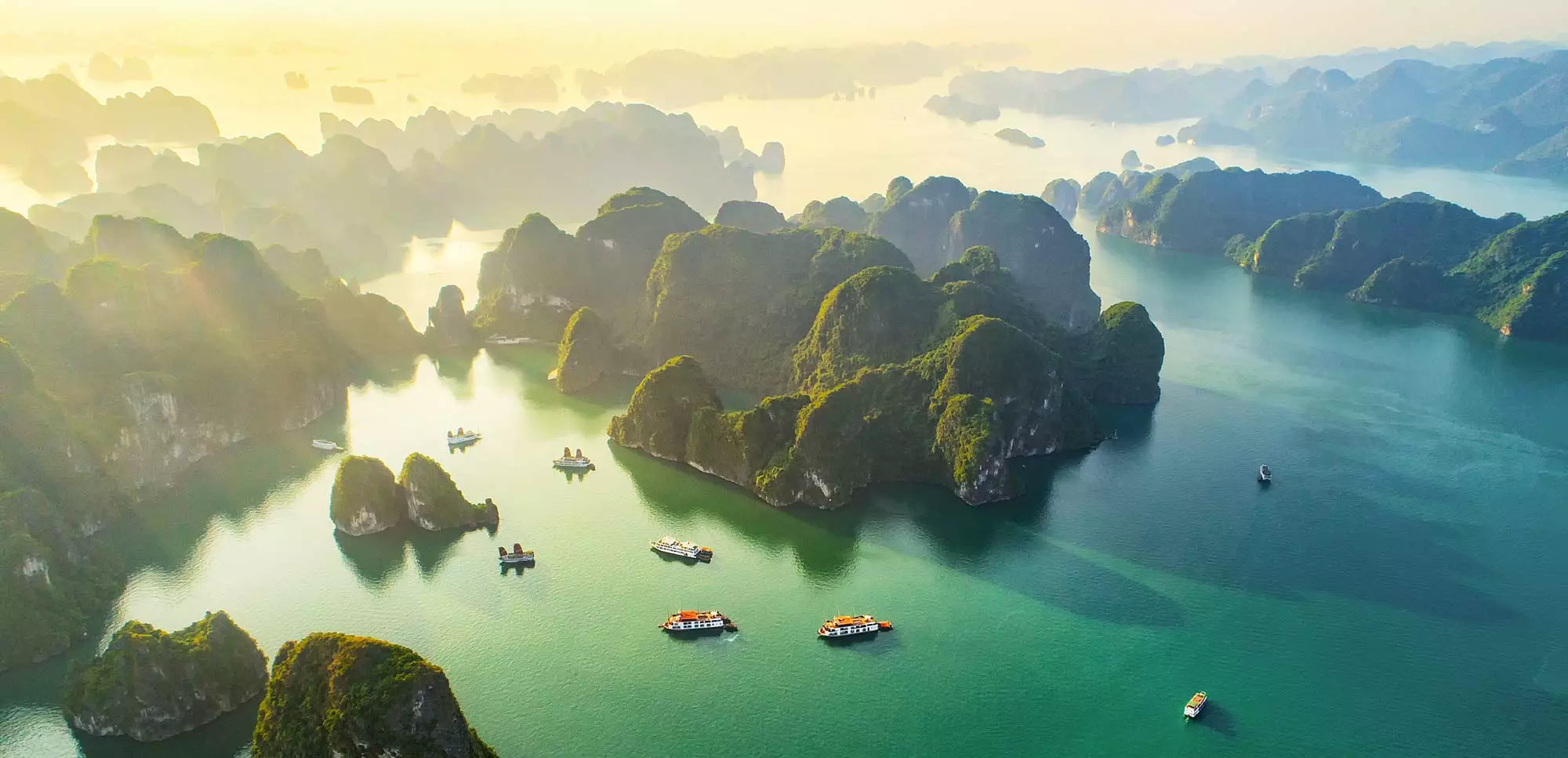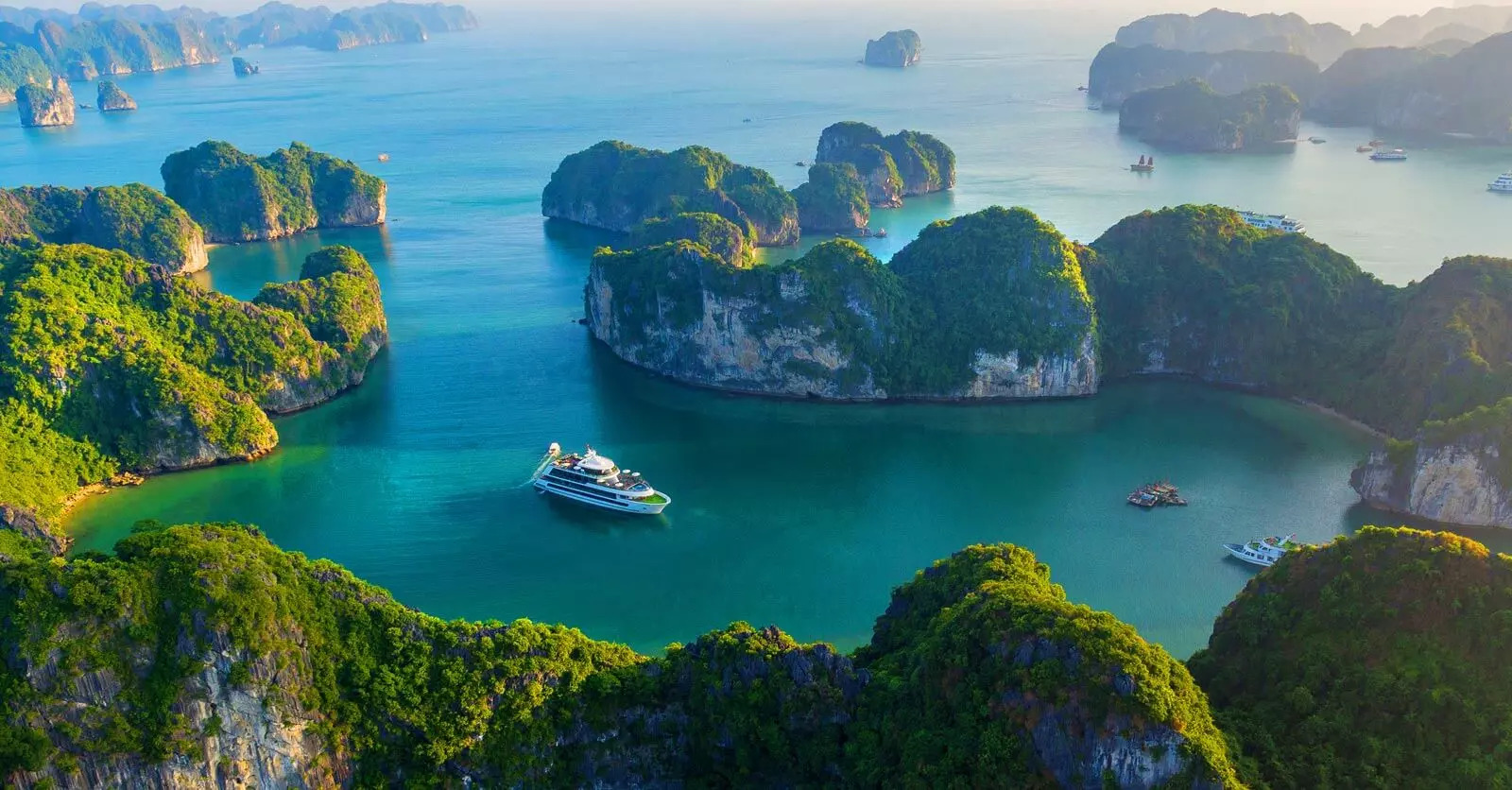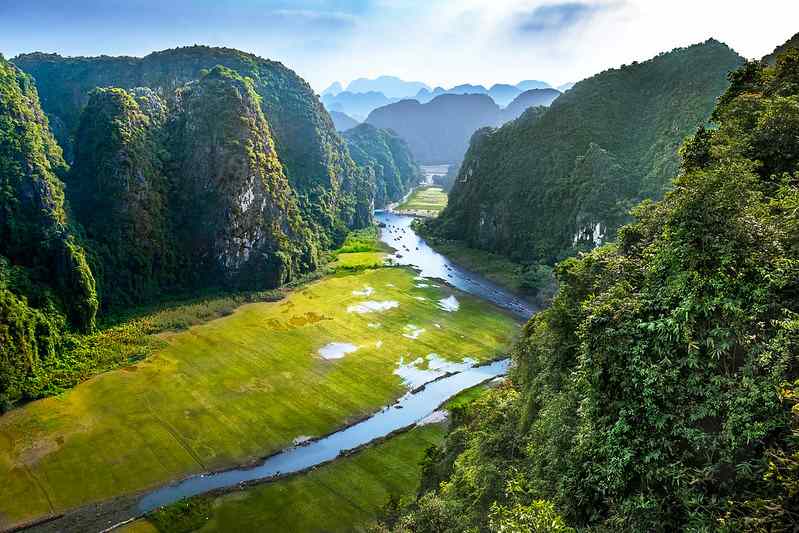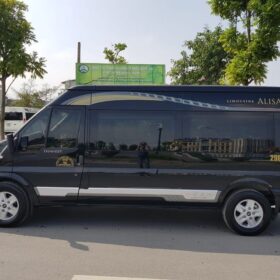Typhoon in Halong Bay 2025-2026: Top 15 Tips Before You Travel
Planning a Halong Bay cruise for 2025 or 2026? Don’t let typhoons catch you off guard! Our comprehensive guide covers everything from peak storm months to real-time safety protocols, helping you navigate typhoon season with confidence.
Understanding Typhoon Patterns in Halong Bay for 2025-2026
Halong Bay’s majestic limestone karsts and emerald waters attract millions of visitors annually, but its tropical location makes it susceptible to typhoons during specific months. Before planning your trip to this UNESCO World Heritage Site in 2025-2026, understanding the region’s weather patterns is crucial.
According to the latest data from the Vietnam National Center for Hydro-Meteorological Forecasting (NCHMF), climate change has slightly altered traditional typhoon patterns. The 2025-2026 season is expected to see:
- Primary typhoon season: June through September
- Highest risk months: July and August (with 65% of all annual storms)
- Average number of typhoons: 2-3 annually (up from the historical average of 1-2)
- Storm intensity: Potentially stronger systems due to warming ocean temperatures
Dr. Nguyen Van Hiep, Senior Meteorologist at NCHMF, notes: “Our 2025 forecasting models show a 15% increase in tropical depression activity in the Gulf of Tonkin compared to the 2020-2023 period, though most will not develop into full typhoons affecting Halong Bay directly.”
When typhoons do approach, local authorities implement a comprehensive safety system with multiple warning levels. The Quang Ninh Provincial Tourism Department has recently upgraded their monitoring stations with advanced satellite technology for 2025, providing more accurate 72-hour forecasts.
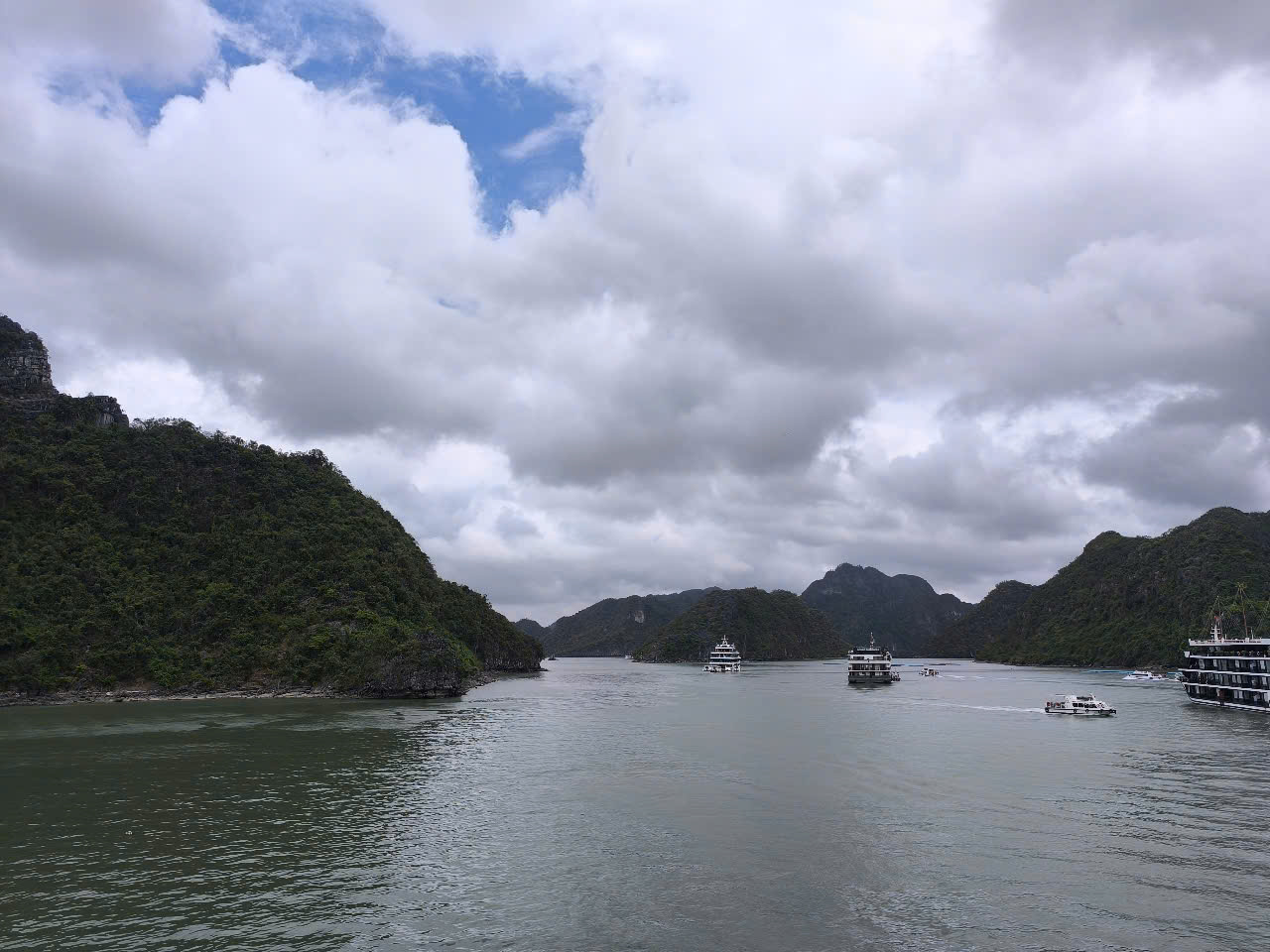
Monthly Breakdown: Typhoon Risk Calendar for 2025-2026
Understanding the monthly risk levels helps you choose the optimal time for your Halong Bay adventure. Here’s a detailed month-by-month breakdown of typhoon probability:
January-April: Minimal Risk Period (0%)
These months offer the most reliable weather conditions with virtually no typhoon risk. January and February bring cooler temperatures (15-20°C) with occasional light drizzle, while March and April offer warming trends (20-25°C) with excellent visibility for photography.
The clear winter air creates stunning misty mornings over the bay—perfect for capturing those ethereal sunrise shots that Halong Bay is famous for. Water temperatures remain comfortable for swimming at an average of 22°C by April.
May-June: Transitional Period (10-20%)
May typically sees the first increase in humidity (80-85%) as the region transitions toward summer. Early tropical depressions may form, but full typhoons remain rare during this period.
June marks the beginning of official typhoon season, though early June statistically faces lower risks than late June. The Halong Bay Management Board recorded only two June typhoons in the past decade, both occurring after June 20th.
July-August: Peak Typhoon Season (40-50%)
These months represent the highest-risk period for travelers. The 2025 meteorological forecast predicts:
- 2-3 potential typhoon systems forming in the South China Sea
- Average rainfall of 320mm in July and 380mm in August
- 75% probability of at least one cruise operation suspension in August
Despite these statistics, many days remain suitable for cruising. Most storms are traceable 3-5 days in advance, allowing for itinerary adjustments.
September: Moderate-High Risk (30-45%)
September historically shows a gradual decline in typhoon frequency, though risks remain significant, particularly in early September. By month’s end, conditions typically improve with decreasing rainfall and wind speeds.
October-December: Declining Risk (5-10%)
October marks the transition to dry season with dramatically reduced typhoon probability. November and December offer ideal cruising conditions with clear skies, lower humidity (60-70%), and comfortable temperatures (18-25°C).
The water clarity during these months is exceptional, with visibility extending up to 8 meters in some areas—perfect for kayaking and swimming activities around the limestone karsts.
Real-Time Typhoon Monitoring Resources for 2025-2026
Staying informed about developing weather systems is essential when traveling during the typhoon season. The Vietnamese government has upgraded its weather monitoring capabilities for 2025, providing tourists with several reliable resources:
- Vietnam National Center for Hydro-Meteorological Forecasting: Official government forecasts with English language options
- Windy.com: Interactive visualization of wind patterns and storm trajectories
- Halong Bay Weather Alert System: Mobile app with push notifications specific to the bay area (launched for 2025 season)
- Global Storm Tracker: Satellite-based monitoring of developing systems across the South China Sea
The Quang Ninh Tourism Department maintains a 24/7 hotline (+84 203 3833 155) with English-speaking staff during typhoon season. This service provides immediate updates on bay conditions and cruise operation statuses.
For tech-savvy travelers, several cruise operators including Halong Bay Lux Cruises have introduced real-time weather monitoring systems integrated into their booking platforms. These systems allow passengers to track developing weather patterns specific to their cruise dates.
How Typhoons Impact Halong Bay Cruise Operations
When typhoon warnings are issued, understanding the operational impact helps travelers prepare for potential changes. Here’s what typically happens:
Cruise Cancellation Protocol in 2025
The Halong Bay Port Authority follows a three-tier warning system:
- Level 1 (Yellow): Potential storm formation 72+ hours away; cruises operate normally with increased monitoring
- Level 2 (Orange): Storm approaching within 48-72 hours; possible itinerary modifications
- Level 3 (Red): Imminent danger within 24-48 hours; mandatory suspension of all cruise operations
According to Captain Tran Minh Hai of the Halong Bay Harbor Master’s Office: “For the 2025-2026 season, we’ve implemented enhanced protocols allowing for partial bay operations during Level 2 warnings, restricting cruises only to protected southern routes when conditions permit.”
Itinerary Modifications During Storm Threats
Rather than outright cancellations, many cruise operators now implement flexible itineraries during Yellow and Orange alerts:
- Route adjustments: Cruising in more sheltered southern portions of the bay
- Duration changes: Converting overnight cruises to day trips
- Activity substitutions: Replacing kayaking with cave explorations during higher winds
- Alternative embarkation points: Utilizing Hon Gai Port instead of Tuan Chau during rough seas
These adaptations have reduced full cancellation rates by approximately 35% compared to previous years, according to industry data from the Halong Tourism Association.
2025 Cruise Cancellation Policies During Typhoon Season
Before booking your cruise, understanding the typhoon-related cancellation policies is essential. For 2025, most reputable operators have standardized their policies:
Premium Operators (Including Halong Bay Lux Cruises)
- 100% refund for government-mandated cancellations
- Free rebooking for up to 12 months with no price increase
- Partial cruise credit (120%) if choosing alternative land tours
- Complimentary accommodation in Hanoi or Halong City for one night if stranded
Mid-Range Operators
- 90-100% refund for government cancellations
- Free rebooking for up to 6 months
- Transfer options to affiliated hotels at discounted rates
Budget Operators
- 70-90% refund based on cancellation timing
- Rebooking options with potential date restrictions
- Limited compensation for additional expenses
Halong Bay Lux Cruises has implemented one of the most flexible policies for 2025, offering a “Typhoon Protection Guarantee” that includes full refunds regardless of when the cancellation occurs, provided it’s weather-related. Their customer service team provides 24/7 support in multiple languages specifically during typhoon threats.
Expert-Recommended Cruises for Typhoon Season 2025-2026
Some cruise options are better suited for the unpredictable typhoon season than others. Based on vessel specifications, itinerary flexibility, and safety records, these options stand out:
1. Shorter Duration Cruises
The 2-Day Halong-Lan Ha Bay 5-Star Cruise offers an excellent balance of experience and flexibility. These cruises can more easily adjust to weather windows, making them ideal during uncertain weather periods. With a shorter commitment, you’re less likely to face multi-day disruptions.
Key advantages include:
- Compact itinerary covering major highlights
- Higher departure frequency (daily vs. 3-4 times weekly for longer cruises)
- Easier rebooking if weather interrupts original dates
- 92% completion rate even during typhoon season
2. Extended Cruises with Diverse Routing Options
For those seeking deeper exploration, the 3-Day 5-Star Lan Ha Bay and Halong Bay Cruise provides access to both Halong and the less-visited Lan Ha Bay. These longer cruises have the advantage of more routing alternatives during marginal weather conditions.
Benefits during typhoon season include:
- Multiple itinerary contingencies based on weather conditions
- Access to sheltered areas in both bays
- Comprehensive typhoon safety procedures and evacuation plans
- Onboard entertainment options during periods of restricted outdoor activities
3. Day Cruises for Maximum Flexibility
Day cruises represent the lowest-risk option during peak typhoon months (July-August). These 6-8 hour experiences allow travelers to make decisions based on the most current weather information, often bookable just 24-48 hours in advance.
Essential Packing List for Halong Bay During Typhoon Season
Preparing for variable weather conditions requires thoughtful packing. For 2025-2026 typhoon season travelers, consider these essentials:
- Waterproof phone case with lanyard (100% waterproof to 30 meters)
- Quick-dry clothing (synthetic fabrics that dry within 2-3 hours)
- Compact travel umbrella with wind-resistant frame
- Anti-seasickness medication (Dramamine or natural ginger alternatives)
- Waterproof backpack or dry bag (minimum 15L capacity)
- Portable battery pack (20,000mAh recommended during potential power outages)
- Slip-resistant water shoes for wet decks and excursions
- Light rain jacket or poncho that packs small
- Microfiber towel that dries quickly between uses
Remember that most cruise ships provide limited storage space in cabins (typically 5-7 square meters of floor space), so packing efficiently is essential.
Alternative Activities When Cruises Are Cancelled
If your cruise faces cancellation, several engaging alternatives allow you to maximize your time in the region:
Halong City Exploration Options
The city itself has developed significantly as a destination, offering:
- Sun World Halong Complex: Vietnam’s largest theme park featuring the world’s tallest cable car over water (188.88 meters above sea level)
- Quang Ninh Museum: Award-winning architectural marvel housing 60,000+ artifacts from the region
- Bai Chay Beach: 500-meter stretch of manufactured beach with protected swimming areas
- Halong Night Market: 1.2km shopping street with 100+ vendors selling local specialties and crafts
Nearby Cultural Excursions
Within 1-2 hours of Halong Bay, these alternatives provide rich cultural experiences:
- Yen Tu Mountain: Ancient Buddhist pilgrimage site with temples dating to the 13th century
- Co To Island: Accessible via hydrofoil when only certain parts of Halong Bay are closed
- Vung Vieng Fishing Village Cultural Center: Interactive exhibits on traditional floating life
- Quang Ninh Cultural Village: 56-hectare complex showcasing ethnic minority cultures
Many cruise operators maintain partnerships with these attractions, offering discounted admission for passengers affected by cancellations.
How Climate Change Is Affecting Typhoon Patterns in Halong Bay
Recent scientific research provides important context for understanding future typhoon risks in Halong Bay:
Shifting Typhoon Seasons for 2025-2026
Climate researchers from Vietnam National University have documented several changes relevant to travelers:
- Extended season: The traditional June-September window has expanded slightly, with occasional systems forming in late May and early October
- Intensity variations: While the overall number of storms remains relatively stable, their average strength has increased by approximately 12% since 2010
- Rainfall patterns: Precipitation during typhoon events has increased by 18%, with more intense but shorter-duration downpours
- Recovery periods: The bay now clears more quickly after storms, with water turbidity returning to normal within 36-48 hours (compared to 72+ hours historically)
Dr. Pham Thi Thanh Huong of the Institute of Meteorology notes: “Our 2025 projections show that while overall typhoon numbers remain consistent with historical averages, their predictability has decreased, requiring more robust early warning systems.”
Adaptation Measures by Cruise Operators
The industry has responded with several adaptations for 2025-2026:
- Enhanced vessel designs: Newer ships feature improved stability systems and higher freeboard
- Satellite communication upgrades: All licensed operators now maintain continuous weather monitoring capabilities
- Crew training enhancements: Mandatory advanced weather response training for all captain-level staff
- Passenger education: Pre-departure briefings now include detailed weather safety protocols
These changes have significantly improved the industry’s resilience to typhoon disruptions while maintaining high safety standards.
Typhoon Safety Protocols on Halong Bay Cruises
When cruising during potential typhoon months, understanding safety procedures provides peace of mind:
Onboard Safety Systems (2025 Standards)
All licensed cruise vessels operating in 2025 must meet enhanced safety requirements:
- Real-time GPS tracking monitored by the Halong Bay Management Board
- Satellite communication systems with 24/7 connectivity to emergency services
- Automatic weather stations providing localized data from the vessel’s position
- Emergency power generators with minimum 48-hour operation capacity
- Reinforced mooring systems designed to withstand Category 2 typhoon conditions
- Comprehensive medical kits with remote physician consultation capability
According to the Maritime Safety Department, the 2025 standards represent a 40% increase in safety requirements compared to 2020 regulations.
Evacuation Procedures During Emergencies
In the extremely rare event of a rapidly developing storm, cruise operators follow these protocols:
- Early return to port when possible (primary strategy)
- Relocation to designated sheltered anchorages (secondary option)
- Shore evacuation to designated secure facilities if necessary
These procedures are tested through mandatory quarterly drills, and all crew members receive specialized training in emergency response scenarios.
Expert Tips for Booking During Typhoon Season
Travel specialists who focus on Vietnam offer these insider recommendations for 2025-2026 typhoon season travelers:
Optimal Booking Timeframes
- Book 3-4 months in advance for best rates while maintaining flexibility
- Avoid non-refundable options during July-August regardless of discount
- Consider “shoulder season” cruises (late May/early October) for reduced rates with manageable risk
- Look for “weather guarantee” policies that offer free rebooking
Insurance Considerations for 2025-2026
- Verify typhoon coverage specifically (some policies exclude named storms)
- Select “cancel for any reason” riders when possible
- Check delay coverage minimums (should provide at least $150-200 per day)
- Confirm evacuation coverage includes non-medical emergency transportation
Travel insurance specialist Maria Chen recommends: “For 2025 Halong Bay travelers, look for policies that specifically mention ‘natural disaster coverage’ and offer trip interruption benefits, not just cancellation protection.”
Frequently Asked Questions About Typhoons in Halong Bay
How accurately can typhoons be predicted in 2025?
Modern forecasting technology can now reliably predict typhoon paths 3-5 days in advance with approximately 80% accuracy. The Vietnam Meteorological Department has implemented new modeling systems for 2025 that incorporate artificial intelligence to improve prediction accuracy by an additional 10-15%, particularly for intensity forecasting.
What happens if a typhoon forms during my cruise?
Cruise vessels maintain constant communication with shore authorities and receive regular weather updates. If a typhoon forms during your cruise, captains will immediately implement safety protocols, typically returning to port ahead of schedule. All licensed vessels can reach safe harbor within 4-6 hours from the farthest points in the bay.
Are certain months within the typhoon season safer than others?
Yes. Within the June-September typhoon season, statistical analysis shows early June and late September have significantly lower risk profiles (approximately 15-20% of the risk compared to late July/early August). These “shoulder periods” offer a reasonable compromise between weather concerns and enjoying less crowded conditions.
How do cruise ships prepare for potential typhoons?
Beyond the standard safety equipment, ships operating during typhoon season implement additional preparations:
- Enhanced stability systems active at all times
- Reduced passenger capacity (typically 10-15% below maximum)
- Additional fuel reserves for extended operation if needed
- Supplementary crew members with specialized weather training
- Redundant communication systems with multiple backup options
What percentage of cruises are actually cancelled due to typhoons?
Based on data from the Halong Bay Cruise Association, typhoon-related cancellations affect:
- Approximately 5-7% of all scheduled cruises annually
- 12-15% of cruises during July-August specifically
- Less than 2% of cruises in June and September
- Virtually no cruises outside the June-September window
This means that even during peak typhoon season, the vast majority of scheduled cruises operate successfully.
Conclusion: Making Informed Decisions for Your 2025-2026 Halong Bay Adventure
Halong Bay’s breathtaking scenery is accessible year-round, including during typhoon season, with proper planning and realistic expectations. While July and August present the highest risk for weather disruptions, the enhanced forecasting capabilities and flexible policies for 2025-2026 make it easier than ever to navigate potential challenges.
For travelers with flexible schedules, visiting during October-April offers the most reliable weather conditions. However, those constrained to summer months can still enjoy this natural wonder by:
- Booking with reputable operators like Halong Bay Lux Cruises that offer comprehensive typhoon guarantees
- Building extra buffer days into your itinerary
- Securing appropriate travel insurance
- Maintaining flexibility with alternative activities
Remember that typhoons, while disruptive, are part of the natural cycle that helps maintain Halong Bay’s lush ecosystem and crystal-clear waters. With proper preparation and the right expectations, your journey to this UNESCO World Heritage Site will be unforgettable—regardless of when you choose to visit.
For personalized assistance with planning your 2025-2026 Halong Bay adventure, contact our travel specialists who can help you navigate seasonal considerations and select the perfect cruise experience for your needs.
Contact Information
Website: vietnammarveltravel.com
Email: vietnammarveltravel@gmail.com
Phone: +84.978.358.422
WhatsApp: +84 978.358.422
Vietnam Marvel Travel – Your Gateway to Authentic Vietnam Experiences
Read Our Reviews: Check out genuine traveler experiences and ratings on Vietnam Marvel Travel Review on TripAdvisor to see why we’re the preferred choice for Vietnam adventures.

